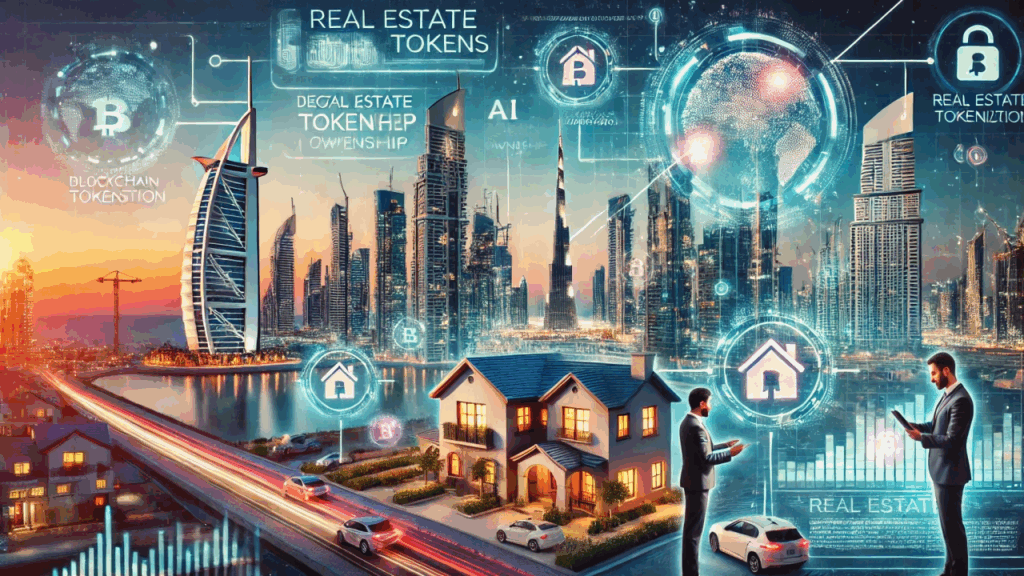Real estate has long been viewed as a stable and tangible form of investment, a cornerstone of both personal wealth and institutional portfolios. From luxury residences and shopping malls to healthcare centers and industrial parks, physical property has reliably generated income, preserved capital, and offered long-term growth. In many Arab countries, real estate ownership also carries cultural significance, often seen as a marker of financial security and legacy.
However, the concept of real estate is rapidly expanding beyond the physical world. The emergence of the metaverse—a digital, immersive, and interconnected virtual universe—is introducing entirely new forms of property ownership. Within this digital environment, users can purchase, trade, develop, and even lease virtual land. These plots of digital real estate often represented as NFTs (Non-Fungible Tokens), are bought with cryptocurrencies and managed on blockchain networks.
At the same time, traditional Real Estate Investment Trusts (REITs) continue to provide investors with access to physical real estate portfolios. These vehicles pool capital from multiple investors to acquire income-producing properties, distributing the returns as dividends. REITs are highly regulated, professionally managed, and deeply embedded in financial systems worldwide.
This article explores and compares these two dramatically different forms of property investment—virtual real estate in the metaverse versus conventional REIT structures—highlighting their respective characteristics, benefits, risks, and implications for the future.
The Essence of Physical REIT Investments
Real Estate Investment Trusts (REITs) are companies that own, operate, or finance portfolios of income-producing real estate. Investors buy shares in a REIT, much like they would in a traditional corporation, but instead of offering products or services, the company derives revenue from leasing real estate, collecting rents, or earning mortgage interest.
Publicly traded REITs are listed on stock exchanges, making them accessible to retail and institutional investors alike. Other REITs are private and available only to qualified investors, typically through real estate firms or fund managers. REITs offer consistent dividend payouts, a degree of liquidity (in the case of publicly listed ones), and professional asset management.
Governments in many countries—including the United Arab Emirates, Saudi Arabia, and Egypt—have established regulatory frameworks for REITs, encouraging transparency, investor protection, and access to real estate markets without the complications of direct ownership.
Understanding Virtual Real Estate and the Metaverse

Virtual real estate refers to digital land and property that exists inside metaverse environments. These virtual platforms, such as Decentraland, The Sandbox, and Otherside, allow users to purchase plots of land using blockchain technology. Each parcel is typically tied to an NFT, which certifies ownership on a decentralized ledger. These NFTs are tradable and verifiable, with ownership managed by a private digital wallet.
Within these platforms, landowners can build virtual structures, rent spaces for events or advertising, and even monetize their properties through virtual shops, concerts, or games. Some companies have used virtual plots to create branded experiences, while artists and musicians have staged digital events drawing thousands of users. The economics of this space operate on the principles of scarcity and community engagement. Platforms usually offer a limited number of plots to maintain value and simulate real-world constraints.
Although the metaverse is still evolving, major corporations, celebrities, and investors have begun acquiring virtual land, betting on the idea that these immersive environments could one day host mainstream commerce, entertainment, education, and social interaction.
Ownership and Legal Clarity
One of the most significant differences between REITs and virtual real estate lies in ownership.
REIT investors typically own shares in a legal corporate entity. This entity, governed by national laws, holds property titles, collects rent, and distributes earnings. Shareholders do not own the properties directly but are entitled to income and potential appreciation through their equity in the REIT.
On the other hand, virtual real estate ownership is defined by digital tokens recorded on blockchain systems. These NFTs confirm that a wallet address holds a certain parcel of virtual land. However, this ownership is only valid within the digital ecosystem of the platform. There is no legal recognition of this ownership outside the terms and conditions of that specific virtual world. The platform operators can impose rules, make changes, or even revoke access under certain conditions.
This makes REITs far more reliable from a legal perspective. Their ownership is enforceable in court, governed by company law, and subject to regulatory oversight. Virtual real estate ownership, while technically secure on the blockchain, is largely dependent on platform stability and may not offer legal protection if disputes arise.
Income Potential and Monetization Strategies
REITs generate income through leasing and property operations. For instance, a healthcare REIT earns revenue from hospital tenants, while an industrial REIT might lease warehouses to logistics companies. These revenues are pooled and distributed to investors regularly, providing a dependable stream of passive income.
The income model of virtual real estate is much less established. Owners of virtual plots may earn revenue by renting their space to advertisers, event organizers, or developers. In theory, a digital billboard on a busy metaverse avenue could generate advertising revenue or a virtual showroom could be leased to an e-commerce brand. Some platforms have already seen this model in action, but the scale is still limited compared to traditional real estate.
Moreover, income from virtual property is highly speculative. Its success depends on user engagement, platform popularity, and the creativity of the landowner. By contrast, REIT income is backed by tangible assets and long-term lease agreements, making it more predictable and less vulnerable to trend cycles.
Liquidity and Market Dynamics
REIT shares, especially those traded on major exchanges, offer relatively high liquidity. Investors can buy or sell shares during market hours, track prices in real time, and benefit from structured disclosure and reporting. While private REITs are less liquid, they often offer redemption programs or secondary markets for share transfers.
Virtual land, despite being tradable around the clock on blockchain marketplaces like OpenSea, suffers from liquidity challenges. The market is less mature, and there may be few buyers at any given time, especially during broader downturns in the cryptocurrency sector. Prices for virtual property can swing wildly based on hype, sentiment, and platform updates. This makes virtual real estate a more volatile and less liquid asset compared to REITs.
Volatility and Risk Considerations
The risk profile of REITs is tied to economic cycles, interest rates, and the health of the real estate market. Rising rates can impact REIT valuations, while tenant defaults or sector-specific downturns (e.g., retail) can reduce income.
However, the underlying assets—buildings, land, and leases—provide a level of fundamental value. This acts as a buffer during downturns and helps REITs recover over time.
Virtual real estate, meanwhile, is exposed to an entirely different set of risks. Platform dependency is high; if a metaverse platform loses users or fails to innovate, its virtual land may become worthless. The value of virtual property is also tied to the price of cryptocurrencies like Ethereum, which can be highly volatile. Furthermore, the regulatory status of digital assets remains uncertain in many countries, and investors may face limitations in legal enforcement, taxation, or ownership recognition.
Investor Demographics and Accessibility
REITs appeal to a broad range of investors—from institutional funds and pension schemes to individual savers and retirees. Their accessibility through brokerage accounts, ETFs, and retirement platforms has made them a mainstream investment option.
Virtual real estate, in contrast, primarily attracts crypto-native individuals, tech enthusiasts, and speculative investors. It requires familiarity with digital wallets, blockchain transactions, and NFT marketplaces. While some platforms are working to simplify the user experience, there remains a technological barrier for average investors.
That said, younger generations—particularly Gen Z and digitally connected millennials—are showing a growing interest in the metaverse. For them, the idea of owning land in a virtual world may be as appealing as buying an apartment in a busy capital city was to earlier generations.
Cultural and Regional Perspectives
In Arab countries, physical real estate investment continues to dominate as a preferred wealth-building strategy. Properties in cities like Riyadh, Cairo, Jeddah, and Dubai are seen as valuable assets with strong rental yields and appreciation potential. REITs allow investors in these regions to access real estate without the challenges of direct ownership, aligning well with cultural preferences for income-generating, tangible assets.
Virtual real estate is still in its early stages in the region but could find fertile ground in areas with strong digital infrastructure. Countries like the UAE and Saudi Arabia are actively promoting innovation in blockchain, NFTs, and metaverse platforms. Initiatives such as Dubai’s Metaverse Strategy aim to position the emirate as a hub for digital economy leadership, which could eventually normalize the concept of virtual land ownership.
In this context, virtual real estate could evolve into a complementary asset class—one that coexists with traditional models and potentially serves as a platform for showcasing cultural heritage, virtual tourism, or e-commerce in a regional context.
Environmental and Sustainability Factors
Physical real estate has a significant environmental impact through construction, maintenance, and energy use. REITs are increasingly addressing this through green certifications, energy-efficient buildings, and ESG reporting.
Virtual real estate, while less resource-intensive physically, is not without its environmental concerns. The energy consumption of blockchain networks, particularly those using proof-of-work mechanisms, has drawn criticism. However, the industry is shifting toward more energy-efficient models such as proof-of-stake, which dramatically reduce emissions.
Still, from a sustainability perspective, physical and virtual real estate each have their challenges and innovations to consider.
The Future: Competition or Convergence?
Rather than viewing these two models as mutually exclusive, it’s more productive to see them as part of a larger evolution in property investment.
Some REITs are already exploring digital transformation—tokenizing shares for easier transfer, using blockchain for lease management, or exploring virtual showrooms and digital twins. Meanwhile, metaverse developers are borrowing concepts from real-world real estate—offering leasing, zoning, and even mortgages for virtual plots.
In the coming years, we may see the rise of hybrid models: a hotel REIT launching virtual extensions of its properties in the metaverse; a shopping mall REIT integrating augmented reality experiences through NFTs; or even fully blockchain-native REITs offering exposure to both physical and virtual assets.
Conclusion
The emergence of virtual real estate in the metaverse represents a bold new chapter in property investment. It opens doors to innovation, accessibility, and creative monetization, especially for younger, digitally native investors. However, it is also fraught with volatility, legal uncertainty, and reliance on emerging technologies that are not yet mature.
Conventional REITs, while less exciting, offer reliability, transparency, and a long-standing track record of performance. For investors seeking regular income, diversification, and regulatory protection, REITs remain one of the most practical ways to gain real estate exposure.
Ultimately, both asset classes serve different purposes. While REITs will likely continue as the backbone of property investing, virtual real estate may carve out its niche in a more digital, immersive future.
For investors in the Arab world and beyond, understanding both forms—and how they may interact in the years to come—could provide a meaningful advantage in navigating the next era of real estate innovation.










